#many references to take from the david copperfield film he did as well
Explore tagged Tumblr posts
Text
thinking about how dracula has never been accurately adapted into a film and thinking about how dev patel would play the hell out of jonathan harker
#the work his eyes can do.... GIVE HIM THE ROLE!#many references to take from the david copperfield film he did as well#dev patel#dracula#dracula daily#jonathan harker#karla speaks
3K notes
·
View notes
Text
The Folklore of Supernatural
Part two of a series I started with this post.
I’m reposting this as the second installment of my midseason hiatus “The Folklore of Supernatural” series, even though it was originally written as kind of a long cracky way of looking at the “sleeping beauty trilogy” of episodes in season 14 (The Scar, Mint Condition, and Nightmare Logic.) The original question I was tagged into was “Is Dean actually dreaming?” and I can not find the original post about this, so I won’t tag anyone in particular (you know who you are and I love you because this was fun to write.) I posted it once in the dead of night with no tags, but I’m republishing it as part of my larger take on folklore as a theme in season 14 of Supernatural. Bear in mind that this was written before Optimism, when it became clear that these were not part of an extended dream-sequence, BUT ALSO before The Spear when it was revealed that Michael could repossess Dean. (I’m going to talk a little bit about timing and writing meta, further on.)
I want to say a couple of things before the cut, too. This is a big old Sleeping Beauty post. I know there’s a lot of SB ideas out there in the metasphere but I’ve deliberately avoided them because I wanted to get my thoughts out here and I am Very Slow. Feel free to tag me into other posts, send me asks, whatever, because I think it’s fun to talk about. However, just because this is a “sleeping beauty” meta does not mean I want to go all the way to the end of that metaphor in this series. This particular post is general audience meta. I can’t tell anyone who might read this that no, you aren’t allowed to see a DeanCas parallel in a meta which relies heavily on a romantic fairy tale and one that was a destiel fandom in-joke after Cas died, at that. I will say, though, that I see it, so if you want to duck out now because I’m a lowkey shipper feel free. Also, I can’t endorse predictions based on meta, either, even my own, even when I think there is a big neon “Texan Star” sign saying “destiel goes here;” there is absolutely nothing stopping anyone involved in the show from making a hard left when the signs said we were going right. So rather than seeing this as a defense of DeanCas subtext, let’s call it an experiment in close reading. If nothing else, it will be fun. (Bear in mind that I am a massive dork so my definition of fun involves Charles Dickens.)
Aaand... here we go.
Is Dean asleep, and have the last three episodes (The Scar, Mint Condition, and Nightmare Logic) been a dream? How can we possibly “answer” that question at this point in the show?
We’re trying to speculate about a text that is a constantly moving target. If, for instance, you start to read the novel Their Eyes Were Watching God by Zora Neale Hurston, and you know from a blurb on the back of the book that she was an anthropologist who collected African-American and Caribbean folklore, and you get to the place where the protagonist Janie’s second [redacted] ends, but there are a lot of pages left ahead of you, and you think, wow if this happens a third time, I have a theory that the third [redacted, go read this book] would be special based on what I know about folklore and the “rule of three,” well by the end of the book you will know whether or not you were right. Janie either finds a third [redacted], or she doesn’t, and it’s either special, or it’s not.
Supernatural has not ended, so there is no way of saying “Oh, the main theme we are supposed to take away from this show is ____.” I mean, we can put big money on “family” but still. With a television show, it’s hard to even say, “The over-arching themes in this season are____” until the season finale, because it is a text that is being written, filmed, and published serially. The fluid nature of subtext in serial literature was something I studied under a Brit Lit professor– she said, when we set out to read David Copperfield, that sometimes themes in Dickens concluded early or evolved late, or didn’t pan out, because Dickens changed his mind or was pressured by readers to maintain a character that he hadn’t planned to keep around (I think that character was Micawber but I can not find a shred of evidence anywhere, even in my notes from my Brit Lit class, because she kind of mentioned it in passing and I didn’t like Dickens very much when I was younger, so obviously I didn’t learn it well.) And even when you get to the end of a Dickens serial, you still might not get closure– he totally rewrote the conclusion of Great Expectations because his friends wanted angst with a happy(ish) ending.
But this particular “sleeping” symbolism that has been pointed out is really, really structurally sound and can be very well supported. What it means is (shrug emoji)
Going back to the first post in this series, the support for this reading comes from an understanding of folk tales. I’ll be primarily using European Sleeping Beauty stories, as that is what is most accessible to an American/Western audience. And, it was deliberately alluded to in the text of the show. But first let’s talk about formula tales in more depth because that is what sets this theme up in the very first episode of season 14.
Michael met with three different beings in the season opener Stranger in a Strange Land and asked each of them “What do you want?” This is in no uncertain terms a formula tale found in folklore all over the world, and you know about the rule of three even if you’ve never actually acknowledged it. In Goldilocks and the Three Bears, for instance, Goldilocks tries two bowls of porridge before finding one to her liking. She tries two chairs before settling on Baby Bear’s chair. She tries two beds before falling asleep in the one that was “just right.” There were three challenges, two of which failed and one that satisfied her. Goldilocks is an original work (and please read the Wikipedia article, it is fascinating how many revisions this story has gone through, and in fact “Goldilocks” wasn’t even the original main character) but it was based on a folk formula and has entered American oral tradition. Similarly, in the German folk tale The Three Little Pigs, the first pig’s house is destroyed because it was made of straw, the second house failed because it was made of sticks, but the third house was made of brick and withstood the huffing and puffing of the wolf. So the pattern in the rule of three is often two challenges that fail or are flawed and one that finally succeeds or satisfies the necessary conditions. For short, I’m going to call this grouping 2/1. In the Michael story, 2/1 is human, who fails, then angel, who fails, then monster, who Mikey likes. In addition, there is a primer to the rule of three in that first scene, just to make absolutely certain that the audience notices it-- Michael has Jamel guess his identity three times.
This 2/1 formula could be just something Dabb did because he wanted to do it. It’s ancient, and Michael is an ancient being. But. Can it also mean that “folktales” is a theme on the show now?
As the saying goes, “Once is an occurrence, twice is a coincidence, three times is a pattern.” Folklore continues into the season in many different ways.
In Gods and Monsters, the scene where Dean shakes loose and punches the mirror probably lit up everyone who saw it with “mirror mirror on the wall” vibes, from the story of Snow White. The enchanted mirror is such a common “trope” in folklore that it has an index number that folklorists and others use to refer to it in their scholarship– it’s Aarne-Thompson index number D1163. So, another solid subtextual reference to folk tales. There is so much more in that episode about storytelling and retelling and the concept of sequels, but that’s for another discussion.
We get to The Scar and Jack mentions Sleeping Beauty and no lie I ascended for a full minute. “Sleeping Beauty” is Aarne-Thompson-Uther Classification of Folk Tales number 410 because this is another story that is found freaking everywhere. (I have to make an aside about the use of the term “folk tale” just because it is in my nature not to leave things like this ambiguous– it isn’t completely certain that the Sleeping Beauty we know of Brothers Grimm and Disney fame is 100% for shore an oral tale, or at least isn’t a tale that got a little finessed when it was first written down. See, a guy in pre-Renaissance Naples named Giambattista Basile included a version of it in a collection of child’s tales hundreds of years ago (it’s horrifying btw, cw for non-con at the very least if you go looking for it) then Charles Perrault (of Puss in Boots fame) got hold of it and rewrote it in French, and folklorists are pretty certain that the story of “Briar Rose in the Forest” that the Grimm brothers collected was the Perrault story that had made its way back into oral tradition in Germany. And, like, it’s not a huge reach to say that the history of the Sleeping Beauty story that is explicitly mentioned in the show’s dialogue by Jack is more subtext about how stories are transmitted, how they are told, what happens when they get loose in the wild, etc. That’s how allusions work, and that’s coming up in my third post.)
So, three times means green light to consider “folk tales” an official thing this season, at least for a while. And the cherry on top is that Sleeping Beauty was the third story referenced. It’s neat.
But NOW. On to THE question the OP posed:
Have the last three episodes been Dean’s dream?
I’m going to pass up surface mentions of dream states and solely focus on the actual “sleepers” in these episodes in order to get at the allusion’s architecture.
In Nightmare Logic, the sleeping beauty OP has identified is Sasha’s father, who is locked in a dream-state by a djinn. In Mint Condition, the sleeping beauty is Stuart, who is in a mysterious coma-like sleep after an attack by a possessed chain-saw. In The Scar, Lora is in a sleep-adjacent death-state after being hexed by a witch. (I saw that her name on the iTunes subtitles is “Lora” which is a variation of Laura but spelled this way evokes “of lore” and that was pretty neat. Another tiny detail that bolsters the theme.)
Is Lora really a sleeping beauty, though, and why is that important?
Remember our rule of three pattern that we were given in the premiere– 2/1. Two people in this group will be more similar to each other than to the third. Both Stuart and Sasha’s father are alive, while Lora is technically all the way dead when she is in the sleep-like state. Superficially, Stuart and Sasha’s father are men, whereas Lora is a woman. Just throwing that out there. If I were writing this post for a grade, that right there is called “padding for word count.” But it is also a valid point, so we’re going to use it. Neither Stuart nor Sasha’s father are shown to resume consciousness by the end of their episodes– Stuart not at all, and Mr. Rawlings only stirs fitfully. Lora is revived when Jack breaks the spell. On the other hand, Stuart is never in continued danger in Mint Condition after his “touch and go” operation (he’s presumably safe inside the salt circle) and is expected to recover naturally, whereas both Mr. R and Lora will die/stay dead if the threat against them isn’t neutralized. Mr. Rawlings is similar to Lora because they are both under “medical care”– Mr.R is ostensibly in hospice and Lora is in the Bunker’s sick bay, and to top things off Stuart is the only one who was treated by an actual doctor: Mr. R‘s nurse was a djinn and Cas is not a doctor he just played one on TV.
The thing about close readings is that anything you can argue is probably valid, but one thesis might be better supported than another. I’m really really tired and there might be more differences and similarities that I am missing. But when you’re gathering the evidence to support a theory about a text, you can end up going a bridge too far and you’ll find yourself staring into the void, completely unable to make any progress, so at some point you just have to stake out your foundations and start digging. (Yeah, I mixed metaphors, I mixed three of them, it’s awesome, get off me.)
So. There is more evidence that Stuart and Mr. R are more similar to each other than either one is to Lora. If we apply the 2/1 template, Lora is the character who satisfies the parameter of being “odd man out.” That still might not make her a sleeping beauty for the purposes of answering the “Is this Dean’s dream” question, and here’s why.
(This is the speculation part. I love this stuff, but again I offer the caveat that using subtext to make plot predictions in Supernatural is like trying to write on a cloud with smoke. Anyway.)
If she’s the sleeping beauty, the subtextual message is that Dean might actually be dead (or might have to die to satisfy the condition that Michael is destroyed.) That possibility was brought up in both 14x01 and 14x02, before Dean came back. And eugh no one wants that. It also means that we had to have read these three episodes backwards to find the character that fits the template, because if Lora is a sleeping beauty, and if she is “the” sleeping beauty for subtextual purposes, she actually came first in the series, and you have to run the episodes backwards to get to the 1. That is subverting the trope. However, if you get the thing you want the first time why go on to the other two challenges? There is a lot in this season about calling back to earlier parts of the narrative to contextualize the present– for instance, in Gods and Monsters, Michael says to the werewolf, “You think you were picking me up in that bar?” or something to that effect and then revealed that he was, in fact, the one stalking her. In Mint Condition, we are introduced to the Janitor Victim as a Dean mirror, but we do not know for certain yet that Hatchet Man is a post-Azazel John Winchester mirror, so that scene is given greater meaning by information that is revealed later in the episode. Structurally speaking, it would be fair to say that the information we have now, that Lora the dead girl is “the” sleeping beauty, based on having seen the other two candidates, means a dead Dean reveal has been primed by the subtext. And like, no thank you?
The other possibility is that Lora, since she was dead and not unconscious, is not “the” sleeping beauty. The third “sleeping beauty” (IF there is one) would show up in 14x06 Optimism. (That title is really stressing me out.) Why would that be Dean and not some other random character? Because if we exclude Laura, the pattern resets from 1/2 to 2/1 beginning with Stuart. Stuart is a Castiel mirror, though, which is not quite right. Mr. R is a John mirror (although that episode is a lot murkier and I’ve said before if someone wants to say he’s a Dean mirror because of the djinn connection I’d agree, in which case BLAM we already have a winner.) [editor’s note, I only left Jack out because we already knew he was dying and thought this subtext was priming a twist, more at ten, this aside has been brought to you by the letters LOL.]
But then, where have the last three episodes come from? If he is dreaming, it could be one reason why the djinn couldn’t wring a nightmare out of him, and that the moment before he killed the monster with a bookend was his subconscious trying to signal to him that something is wrong…
I have said a couple of times that subtext isn’t always predictive. Some authors will have multiple subtexts or will use subtext to straight-up fool you (*waves to thriller writers.*) But the exception proves the rule here– we as readers/viewers rely on subtext to prepare us for what might be coming next. Subtext helps provide that slow build to climax that makes, say, Neville Longbottom’s absolutely stunning house cup win in The Sorcerer’s Stone such a stand-up-and-cheer moment, or that makes Harry Potter’s realization that it is his patronus, not his father’s, that saves his past self in the Prisoner of Azkaban so satisfying. Lack of subtext is the reason there is so much grumping over Mary/Bobby. I mean, they what? Had a walk in the woods together? She called him “old man” once, is that even a term of endearment??? [full disclosure I never liked those two together until after Nightmare Logic.]
And scene!
That up there is where I stopped, and now it’s clear that the person who all this was pointing at was Jack, who fell into a dramatic swoon at the end of Optimism. There were two “sleeping beauties” in that episode, too in the 2/1 pattern of the folktales we’ve discussed– the zombie, who is in sort of a dream state, and Charlie, who is knocked out by fly guy. (Again, fully dead is a red herring and doesn’t count. That’s some positive subtext.) That was basically a lot of words to be able to summarize that, yes, sleeping beauty and dreamstates is a thing so far, but where it was going was hard to predict.
There is something really important that can be taken out of this close reading, though, that is carrying throughout the season.
Jack was the character who actually said the words “Sleeping Beauty.” Jack sort of volunteered himself as tribute. Another theme this season that was made explicit by Subtext Primer aka Mint Condition is that the words characters are saying are more important than they ever have been.
AND ONE MORE THING! The above was written before Unhuman Nature and Byzantium and The Spear! Dean has been put back to bed by Michael! But but Castiel stepped into the Sleeping Beauty deal! Where are we going! There’s no earthly way of knowing, which direction we are going…
Anyway in the next installment of this really long meta that will probably never end I want to explore what the history of the Amero-European Sleeping Beauty brings to bear on this season.
68 notes
·
View notes
Text
The Séance Circle Part Two: Davenports, Cabinets, and Other Furnishings
There's obviously a significant gap between the aquatic critters and bat-winged cats flying around St. Anthony's head in an old painting reproduced in an old book on the one hand and a Marc Davis concept sketch for the Haunted Mansion Séance Circle on the other, and there's another gap between that sketch and what eventually was built into the ride. By now, that's what we've come to expect around here. In many cases, the gaps are such that you can't recognize any traces of the original inspiration in the finished product. Not here. Davis's squiddly creatures and airborne felines notwithstanding, for the most part the Séance Circle is the place in the Mansion where the line between source material and finished product is the thinnest. ��At times, the Imagineers merely reproduced an effect directly. Hey, I wonder where they got the idea of hanging a bell by thin wires so it could float around overhead?

Call me crazy, but I think that possibly they got the idea from séances where a bell was suspended by thin wires so it could float overhead.
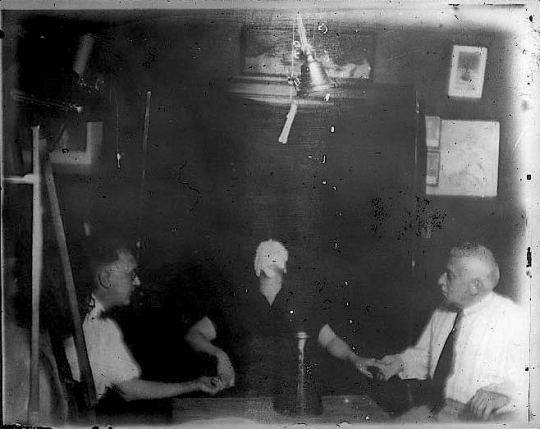
Our sources are 19th and early 20th century séances and ghost shows, of course. The period from about the 1850's to the 1920's was the heyday for mediums, spiritualists, and "spirit photography," as well as a heyday for theatrical and parlor magic shows—not coincidentally. It's hardly worth the trouble, for our purposes, to try to sort out the tangled continuum between real, sincere spiritualists and real, sincere attempts to contact the dead via séances at one end of the spectrum and openly-stated illusioneering for entertainment purposes by stage magicians (in the David Copperfield sense of the word) at the other end. There were those, and there was also everything in between. You had fraudulent mediums who insisted they were genuine even while admitting to using tricks now and then, and you had stage magicians who flatly denied they were mediums but also claimed that the ghosts they produced onstage were real. Harry Houdini was a famous skeptic and used his knowledge and expertise in professional stage magic to debunk spiritualists and mediums. These efforts did nothing to keep some people from believing Houdini was himself gifted with psychic powers. The blurring of lines makes sense if you think about it, since a good fraudulent medium is almost by definition a good illusioneer, a good magician. Some of the Haunted Mansion Imagineers were card-carrying magicians (Yale Gracey and Rolly Crump), with a natural interest in all of that stuff. Is it really a surprise that apart from the spectacular Madame Leota effect (which nevertheless may owe something to 19th c. magicians like Harry Kellar), the main difference between the HM séance and a "real" 19th-early 20th c. séance is the fact that one is an honest fake while the other is a dishonest fake? Otherwise, they're both going about the same business: creating realistic-looking spiritualistic effects that could fool a gullible soul under the right circumstances. In fact, the HM version is historically realistic enough to require some annotation. And that's our job. Begin with the ectoplasm ball floating around behind Madame L.
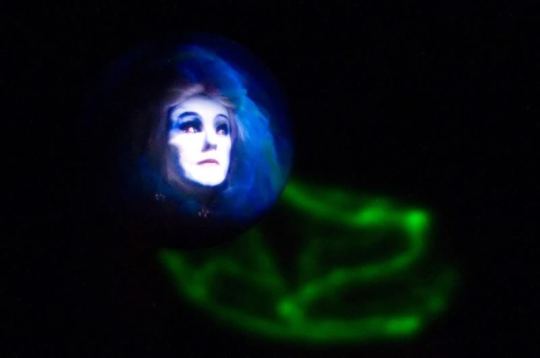
(pic by Jeff Fillmore, SCL photography)
Ectoplasm was commonly produced at séances, usually manifested as a white-ish substance oozing from somewhere on the medium's body. In photos it looks suspiciously like chewed up gauze or paper, and even if you're a true believer, those photos are embarrassments. Real eye-rolling stuff. There's some ecto on the face of the medium in that earlier photo. In "spirit photography," you sometimes saw ectoplasm leaving glowing trails. Not much different than the Disneyland version, really, even if they couldn't figure out how they wanted to spell "ectoplasm" on the Effects blueprints.

Even when the Disneyland version started making faces at guests early in 2006, they weren't departing from tradition, since faces often appeared in clouds of ectoplasm at the "real thing."

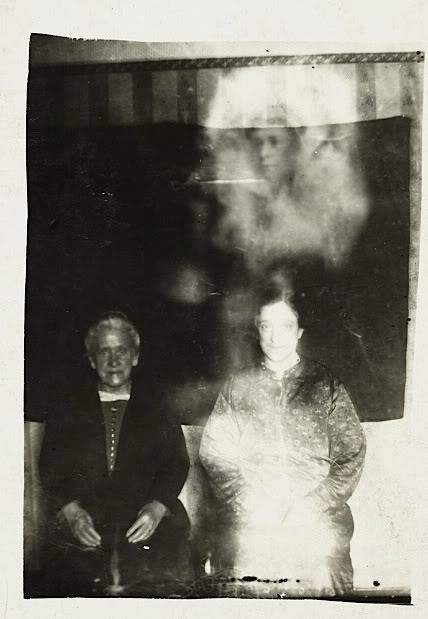
The Davenport Brothers
So far we've been talking about the 19th-early 20th c. phenomena in general. If there was a specific historical inspiration for the HM Séance Circle, it was the stage act put on by the Davenport brothers. These are the guys who disclaimed being mediums while suggesting that the ghosts were real. They started in the 1850's and were a very big act throughout the '60's. It all came to an end when one of the brothers died unexpectedly in the 70's.
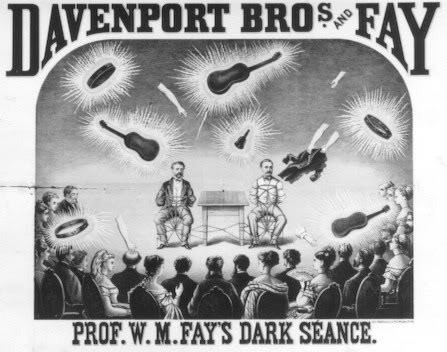
What they really were were top-notch escape artists and illusioneers, with an excellent staff of assistants who never got caught and never blabbed. The Davenports would be tied up good and tight, and then as soon as the lights went out musical intruments started flying around and ghostly hands and arms appeared, touching people and scaring 'em good. On with the lights, and there are the D bros, still tied up. They invented the "spirit cabinet" for their act. It was a large cabinet in which they both sat, all tied up, sometimes with an audience member sitting between them. After the lights went out, the usual levitations and creepy manifestations followed.

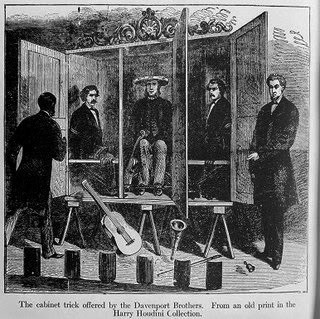
It didn't take long for professional mediums to recognize the advantages of having a large cabinet to work with. The "spirit cabinet" very quickly became a standard fixture at séances. With perfectly straight faces the mediums spoke of the cabinet as a kind of "spiritual storage battery." Seriously. Most often, the "cabinet" was not a wooden chest but a tent or a booth in the corner of the room. The medium might sit in it or at its entrance or in front of it, while spirit manifestations appeared in front of the cabinet.

"And look how fast that button spins when I pull these back and forth!"

Wow, how do they do that?

Okay, nevermind.
It's easy to make fun of these phonies and the people taken in by such simple tricks, but many of these mediums were highly skilled magicians in their own right. It takes practice. I mean, how many people can control their urine stream like this?

Spirit cabinets are present at the Haunted Mansion séance, although it's doubtful if many guests recognize them for what they are. Both types can be seen behind Madame Leota.

It originally looked more like this under show conditions, of course:
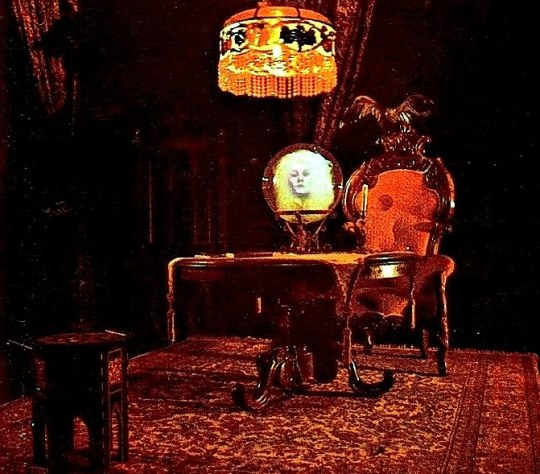
As previously noted, the Séance room in the Haunted Mansion is yet another idea that goes all the way back to Ken Anderson, and if I'm reading this sketch correctly, the novel idea that the medium is herself a ghost is also his. Notice that she is emerging from a spirit cabinet, already in this early concept artwork.

Just like the real thing.

Or the real real thing.

Hat tip to Craig Conley. From Puck magazine (1884), perhaps a political cartoon

But getting back to the Davenport brothers, we know about them mostly from written accounts, of course, and one famous description of their act appeared in the London Post. Compare the description of the musical instruments at a Davenport show with what we find in that earlier Davis sketch and in the inner circle of the actual attraction.

Floating tables, even high-flying, large tables, are nothing new to séances.

"Great Caesar's ghost, look at all the old gum wads!"
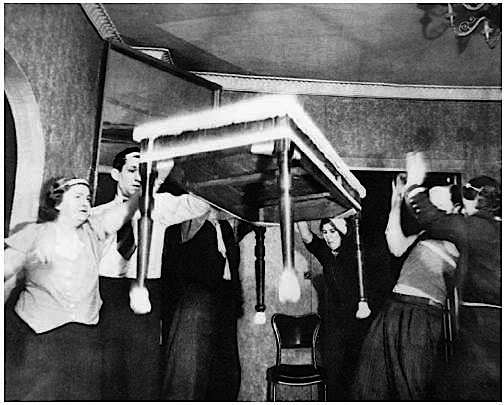
Marc may have wanted flying animals, but I think even he realized that furniture and musical instruments were more authentic. He still couldn't resist throwing in a cat, though.

The musical instruments are the more interesting feature. Madame Leota refers to most of them in her incantations, as you can see right there in her open spellbook . . .
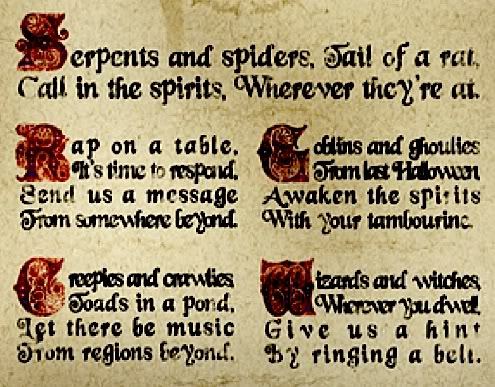
. . . or hear isolated in this sound file:
Leota's Incantations in the Ride [Audio Link]
That gives us a bell and a tambourine. For the horn, drum, and some kind of stringed instrument, we have to cite two incantations that were recorded but never used. Leota's Incantations Never Used [Audio Link]
Horned toads and lizards, fiddle and strum, Please answer the roll by beating a drum. Harpies and Furies, old friends and new, Blow on a horn, so we'll know that it's you. No one knows why these weren't used. It could be something as simple as a head movement during filming that misaligned the face at that point. If you examine the instruments in the posters for the Davenport brothers, you'll see four kinds, the now-familiar horn, tambourine, and bell, plus something to "fiddle and strum," a guitar. It doesn't take much thought to see why the guitar wasn't kept for the HM séance. That instrument has undergone a complete reinvention in popular imagination since the 19th century and now has utterly different connotations. It is no longer even remotely associated with the exotic or the quaint. Oddies and Endies, out of the past, come to us now, and we'll deal with you last. We've noted the connections between the Séance Circle and its historical sources; now it's time to wrap up a few curious odds and ends. Madame Leota's wooden spirit cabinet originally served a very practical purpose. It was going to house the projector that produces her face. Back then, she was going to face in the opposite direction. You would see her face as you enter the room and swing around behind her. This was the plan up until three or four months before the Mansion opened, at most. It was probably ditched because you wouldn't be able to prevent people from seeing the projector at some point as they went by. Looking at the outer ring of floating objects, here are some random observations. The wicker table is part of a set, and other pieces from the same set have been kicking around in the Attic for years and years. The banner on the longhorn says "X = ?" I think it's a sly tribute to X. Atencio, or maybe they're teasing him ("X? What the heck kind of name is 'X' anyway?"). The gong was originally going to be a cluster of three bells. Oh, and you know that floating candelabra back in the Endless Hallway? It was originally supposed to be here in the Séance Circle. The second drum has been missing at Disneyland for a long time. The last time it was certainly seen was in 1991.

Perhaps it will show up on eBay some day.
Forget about the Phantom Drummer of Tedworth; what's the phantom drum overhead worth?
Originally Posted: Monday, August 9, 2010 Original Link: [x]
7 notes
·
View notes